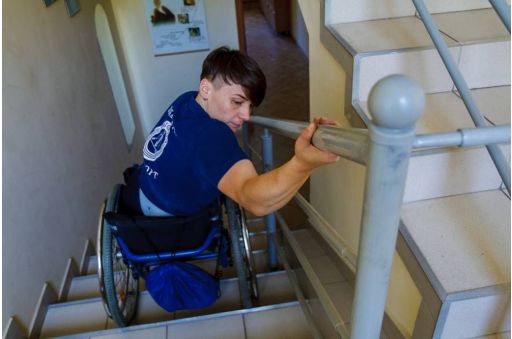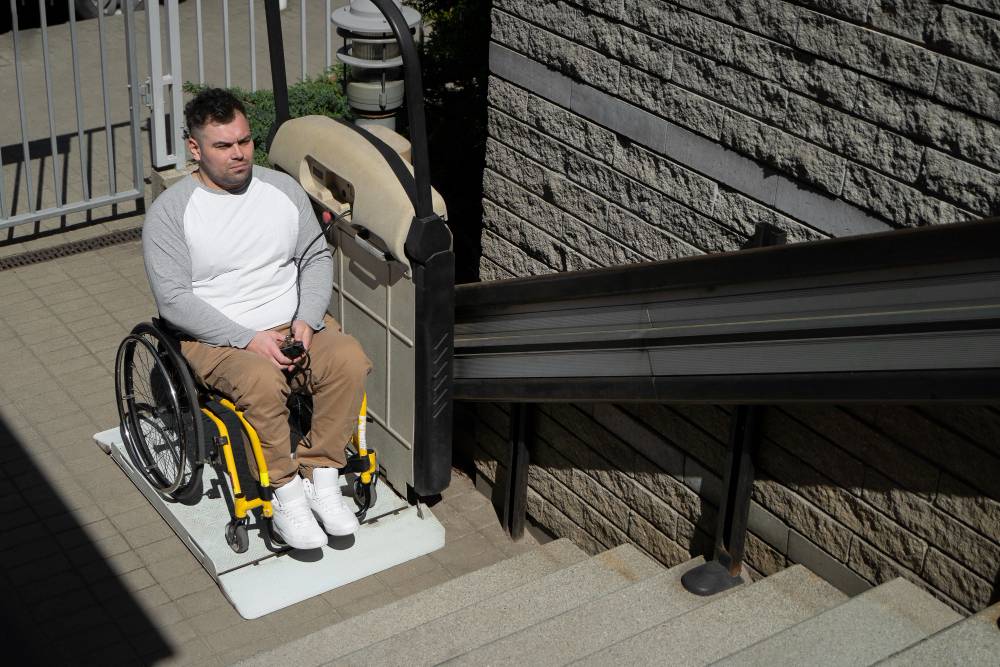
How to Get Wheelchair Up Stairs
Stairs may seem a challenge for those who just switched to a wheelchair, especially the steep ones. The important thing here is to keep the person in a wheelchair safe and comfortable while doing lifting manipulations. This article will help you get the hang of how to get a wheelchair up and down stairs to nail this routine work.
So, How to Get Wheelchair Up Stairs?
Ideally, there should be two people around the person with disabilities who can assist them in getting their wheelchair upstairs. Traversing stairs alone in a manual wheelchair is dangerous and not recommended. At least one assistant should help with getting the chair upstairs. A chair can be lifted manually only in case of short- to mid-length stairs that are designed with a wheelchair ramp and handrails.
One-Person Assistance
- Position yourself behind the wheeling chair, facing the stairs.
- Engage the wheel locks.
- Tilt the wheelchair backward; lift the front wheels slightly off the ground.
- Firmly grip the wheelchair's frame.
- Advance one step at a time, using your body strength to lift the wheelchair over each step.
- Watch proper posture and stance to avoid injury.
- Communicate with the individual throughout the process for their comfort and safety.
- Upon reaching the top, gently lower the front wheels and disengage the wheel locks.
Two-Person Assistance
- One person positions themselves behind the wheelchair, the other in front.
- The rear person engages the wheel locks and tilts the chair back, lifting the front wheels.
- The front person grips the wheelchair frame's front portion.
- In unison, you lift and guide the wheelchair up one step at a time. Maintain communication and coordinate your movements.
- The rear person uses their strength to lift, while the front person stabilizes and directs.
- Pause as needed on each step for the user's comfort.
- At the top, gently lower the front wheels and disengage the locks.
How to Get an Electric Wheelchair Up The Stairs?
Electric wheelchairs are quite heavy, thus, in terms of safety, it’s recommended at least two people assist in getting the power chair downstairs. Place the power wheelchair against the first step. One person stands behind the chair, and this should be a stronger one because this position requires more effort. Place the power wheelchair with the person in it facing away from the base of the stairs.
The rear person should grip the handles firmly while the front person grasps the frame above the casters. Do not grab removable parts like footrests or armrests. The front assistant should maintain a stable stance, with one foot closer to the wheelchair and the other slightly behind for balance.
On each step, the front person should bend their knees, arch their back, and slowly push the wheelchair upwards. At the same time, the rear assistant tilts the electric wheelchair back. Lift and guide the front person onto the next step. Maintain communication and coordinate your movements.
Repeat this process cautiously for each step. Take breaks as needed for the user's comfort and safety.
How to Get Wheelchair Down Stairs?
The process is quite similar to getting upstairs but it has some specific modifications to take into account. The stronger assistant should stand at the back of the wheelchair, acting as the primary spotter. They should stand with a wide stance - one foot under the chair and the other foot back for stability. The wheelchair user should find their balance point while the front wheels are off the ground. The rear assistant turns the chair with its user to face the first step down.
The helper at the front of the wheelchair grasps the frame firmly, avoiding touching removable parts like footrests. They should stand with one foot two steps below the wheelchair. Get ready to assist in lowering the chair down each step slowly.
The assistance can use the command "Ready" to ensure everyone is in position and stand confidently. Use the command "Lower" to initiate the descent. The rear helper counterbalances by leaning back as the chair lowers. The front spotter stabilizes the chair by pushing down on the frame and against the step once down.
When stable, the rear person repositions with one foot under the chair and the other further back. Repeat the sequence for each step until reaching the bottom.
At the bottom, the wheelchair user can turn sideways, engage the brakes, and replace any removed anti-tippers.
Safety Tips to Follow While Lifting a Wheelchair Up and Down Stairs
- Assess the length and angle of the stairs. If there's no caregiver around you, do not hesitate to ask for assistance in case you are not sure you can handle the obstacle. In case the stairs are attached to a facility, check if there’s an assistance button to call for help. Check if there is a ramp or handrails attached to ease the process.
- Avoid any obstacles on the stairs (e.g. litter) or remove them if needed.
- If someone who wants to help get a wheelchair upstairs does not know the wheelchair and its user, make sure they are explained which part of the chair they should hold while lifting up the device. Do not grab unstable, wobbly parts that can be detached, like a footrest or a food tray. The wheelchair frame is a solid place to hold.
- Before stepping up the stairs, make sure that the surface is not wet or slippy so your feet stand still.

Assistive Devices to Help Get a Wheelchair Upstairs
Safety Belt
It’s a little but mighty add-on every wheelchair user must have when going outdoors. A wheelchair safety belt is a restraint device that helps keep the person in a seat secure so they won’t fall or slide out of the chair. Such a safety device is usually made of durable nylon webbing or similar strong material. The belt comes with a buckle or closure to fasten around the user's lap and lower abdomen.
Wheelchair Ramp
Wheelchair ramps make it easier to get up and down, unlike regular stairs. The common types of accessibility ramps are the ones made of metal or wood. The main idea is to create a smooth surface so the wheelchair user can easily travel up and down. This way, owners of electric wheelchairs and mobility scooters can handle the obstacle on their own. You can find portable ramps that can be easily folded and stored in a trunk while traveling.
Stair Lift for Wheelchairs
A stair lift, also known as a wheelchair platform lift, is a mechanical device engineered to safely transport a person in a wheelchair up and down stairs. The device is attached to the wall along the stairs. A wheelchair user rolls onto the platform and secures their position with a safety belt while standing on a platform lift. With the use of a remote control or switch, the person operates the stairlift and moves it up or down the staircase.
Vertical Lift
A vertical wheelchair lift (or porch lift) is designed to get the wheelchair user on the upper or lower floor inside the building. It consists of a platform or deck that travels in a vertical direction along guided rails or tracks. The use is similar to the stairlift - roll onto the platform, secure yourself, and use the remote control to raise or lower the vertical lift to the desired level.
Conclusion
While getting up or down stairs may seem an easy task, wheelchair users frequently face the challenges on a daily basis. Involve constant practice on how to climb stairs in a wheelchair and use the tips from the above guide to make the process less stressful. Don’t be shy to ask for a helping hand if you need assistance with lifting.

